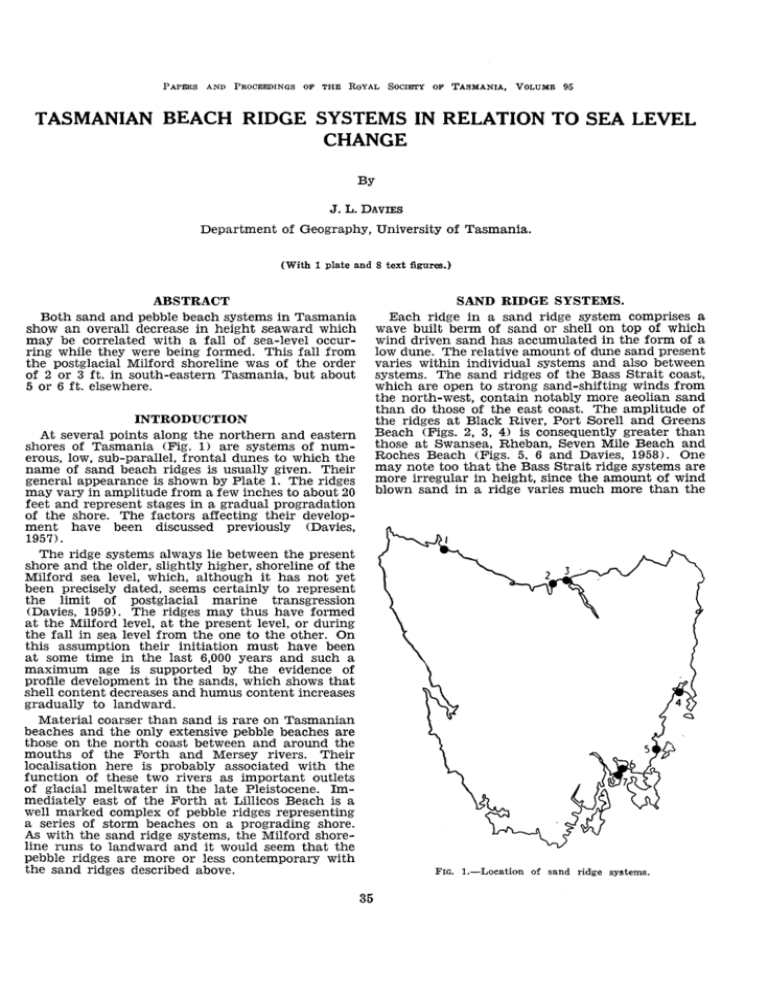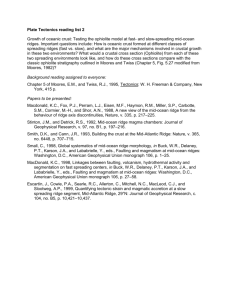TASMANIAN BEACH RIDGE SYSTEMS IN RELATION TO SEA
advertisement

PAPERS
AND
PROCEEDINGS
OF THE RoYAL
SOCIETY
OF TASMANIA.
VOLUME
95
TASMANIAN BEACH RIDGE SYSTEMS IN RELATION TO SEA LEVEL
CHANGE
By
J. L. DAVIES
Department of Geography. University of Tasmania.
(With 1 plate and 8 text figures.)
SAND RIDGE SYSTEMS.
Each ridge in a sand ridge system comprises a
wave built berm of sand or shell on top of which
wind driven sand has accumulated in the form of a
low dune. The relative amount of dune sand present
varies within individual systems and also between
systems. The sand ridges of the Bass Strait coast.
which are open to strong sand-shifting winds from
the north-west, contain notably more aeolian sand
than do those of the east coast. The amplitude of
the ridges at Black River. Port Sorell and Greens
Beach (Figs. 2, 3, 4) is consequently greater than
those at Swansea, Rheban, Seven Mile Beach and
Roches Beach (Figs. 5, 6 and Davies, 1958). One
may note too that the Bass Strait ridge systems are
more irregular in height. since the amount of wind
blown sand in a ridge varies much more than the
ABSTRACT
Both sand and pebble beach systems in Tasmania
show an overall decrease in height seaward which
may be correlated with a fall of sea-level occurring while they were being formed. This fall from
the postglacial Milford shoreline was of the order
of 2 or 3 ft. in south-eastern Tasmania, but about
5 or 6 ft. elsewhere.
INTRODUCTION
At several points along the northern and eastern
shores of Tasmania (Fig. 1) are systems of numerous, low, sub-parallel, frontal dunes to which the
name of sand beach ridges is usually given. Their
general appearance is shown by Plate 1. The ridges
may vary in amplitude from a few inches to about 20
feet and represent stages in a gradual progradation
of the shore. The factors affecting their development have been discussed previously (Davies,
1957) .
The ridge systems always lie between the present
shore and the older. slightly higher. shoreline of the
Milford sea level, which, although it has not yet
been precisely dated. seems certainly to represent
the limit of postglacial marine transgression
(Davies. 1959), The ridges may thus have formed
at the Milford level. at the present level, or during
the fall in sea level from the one to the other. On
this assumption their initiation must have been
at some time in the last 6.000 years and such a
maximum age is supported by the evidence of
profile development in the sands, which shows that
shell content decreases and humus content increases
gradually to landward.
Material coarser than sand is rare on Tasmanian
beaches and the only extensive pebble beaches are
those on the north coast between and around the
mouths of the Forth and Mersey rivers. Their
localisation here is probably associated with the
function of these two rivers as important outlets
of glacial meltwater in the late Pleistocene. Immediately east of the Forth at Lillicos Beach is a
well marked complex of pebble ridges representing
a series of storm beaches on a prograding shore.
As with the sand ridge systems, the Milford shoreline runs to landward and it would seem that the
pebble ridges are more or less contemporary with
the sand ridges described above.
FIG. I.-Location of sand ridge sy.tems.
35
BEACH RIDGE SYSTEMS IN RELATION TO SEA LEVEL CHANGE
36
amount of wave deposited material. The height of
the beach berm is almost entirely controlled by the
maximum height of the constructing waves and this
factor will not show great and erratic variation
from ridge to ridge. On the other hand the thickness of the wind blown material will depend mainly
on the length of time that the ridge operates as an
accumulation form, which in turn will depend on
the length of time which it takes for a new ridge to
establish itself to seaward. This factor is potentially
much more variable.
It could be expected therefore that the height
of the hidden beach berm nucleus would refiect
wave height at the time of construction and, provided other factors such as tidal range and offshore wave refraction patterns remained constant,
any variation in the height of the berm from
ridge to ridge would be an approximate measure
of sea level change. However, this record is sub-
merged beneath the wind blown material capping
the berms, which, because it varies with a different
factor, tends to mask trends which might otherwise be discernible. Even so, it has been suggested
that variation in height of the ridges can be used
as evidence of sea level change and Gill and Banks
(956) pointed to the apparent significance of the
Black River ridges in this connection. Ideally an
exact assessment of trends would necessitate the
identification and levelling of the top of the wave
built section in each ridge, but the writer has
suggested (Davies, 1958) that the calculation of a
line of best fit for surface ridge and swale heights
would give an approximation to sea level trends
over the entire period of ridge formation. The
calculation of lines of best fit by the method of least
squares for ridges and swales at S.even Mile Beach
and Roches Beach showed a gradual overall slope
seaward of about 2 to 3 feet.
30-
28
26
24
L
3
::r: 22
uJ
>
~20
«
f-
w 18
w
LL
16
14
12
BLACK RIVER
2
3
4
678
5
DISTANCE
V.E= 50
IN
HUNDREDS
OF
9
FEET
10
11
FIG. 2.-Profile of sand ridge system at the Black River, with lines of best fit and product moment correlation coefficients (r.).
J. L. DAVIES
37
28
26
~24
3
J:
UJ
22
>
o
~20
I-
UJ
UJ
u.
18
16
PORT SORELL
2
3
4
5
6
DISTANCE
V.E =50
7
IN
8
10
9
HUNDREDS
OF
11
12
13
14
15
FEET
FIG. 3.-Profile of sand ridge system at Port Sorell.
Survey and analysis of other sand ridge systems
has since shown that such simple statistical analysis
of surface form provides an almost consistent story
of correlation between ridge building and sea level
fall. The additional systems analysed were those
of Black River, Port Sorell and Greens Beach on
the Bass Strait coast and of Swansea and Rheban
on the east coast.
mack River (Fig. 2) .-The ridge system at the
mouth of the Black River has been described and
figured by Gill and Banks (956) There is a
ridge amplitude of up to about 17 feet and this
results from the
amount of
dune sand
in
in turn is
reflected in the irregularity
As a
result, although the lines of
fit suggest an
overall seaward slope of the system of about 9 feet
for ridges and 5 feet for swales, the fit is not a
particularly good one and the product moment
correlation coefficient (r) in each case, while
satisfactory, is not very high.
Port Sorell (Fig. 3).~-The wide
Port Sorell is partly closed
bar, progradation of which
extensive sand ridge system
show great variation in amplitude
profile poses some difficulties. The greatest of
perhaps is due to the presence of the highest
(28 ft. above H.W.MJ ridge close to the seaward
edge of the system. In calculating the lines of
best fit only the ridges and swales behind this ridge
have been used, on the assumption that the
exceptionally large ridge marks a point of sudden
and marked slowing in the ridge building process
with the consequent accumulation of a much larger
mass of dune sand. Such a procedure is open to
criticism on grounds of subjectivity and since the
correlation coefficient for ridges here is a low
one (0.40), it would seem preferable anyway to
treat the evidence of the Port Sorell ridges with
some reserve.
Greens Beach (Fig. 4). Greens Beach is near
Kelso, immediately west of the Tamar mouth, and
here there is a well defined system of over twenty
ridges with amplitudes of 1-6 ft. They contain a
smaller amount of dune sand than do the ridges at
Black River and Port Sorell so that the correlation
coefficient for the line of best fit is very satisfactory
«(LS!). The lines of best fit suggest an overall drop
in height seaward of 10 ft. for ridges and 8 ft. for
swales.
Swansea (Fig. 5), The ridge system at Swansea
occurs on the large spit of Nine Mile Beach which
almost closes the head of OYster Bay. The system
is a large one, being about three-fifths of a mile
wide, but the ridges are the lowest and least distinct
of any surveyed. The amount of wind blown sand
which they contain is very small and excavation
suggested that it does not cap the underlying beach
berms to a depth of more than 2 feet.
The result is that correlation coefficients are very
high (0.88 for ridges and 0.92 for swales) and the
system shows a very clear and steady slope seaward of about 5-6 ft.
Rheban (Fig. 6). The Rheban system, while genetically similar to the others, is different in two
main ways. In the first place, two cross profiles
of this system showed an overall tilt to landward
instead of to seaward as in all other instances. One
of these profiles is analysed in Fig. 6 where a tilt
of 2-3 ft. is suggested by lines of best fit. The second
difference, which is undoubtedly connected with
the first, lies in the much more complicated history
of this system. The ridges comprise a bar in Carr~ckfergus Bay at the mouth of the Sandspit River
BEACH RIDGE SYSTEMS IN R,ELATTON TO SEA LEVEL CHANGE
38
23
21,
19
::; 17
3:
J:
w 15
>
0
---~OGc-s
--_
m
< 13
r~a
..... -;f!/
I-
w
W
IL.
11
9
VE·50
7
GREENS BEACH
2
5
4
3
--
6
7.
DISTANCE
8
IN
9
HUNDREDS
13
12
10
11
OF FEET
15
14
16
FIG. 4.-Profile of sand ridge system at Greens Beach.
10
11
12
13
14
IS
16
17
18
19
20
21
22
23
24
2S
26
27
~
29
Xl
31
J2
DISTANCE IN HUNDREDS OF FEET
FIG. 5.-Profile of sand ridge system at Swansea. Dunes at the extreme right have heen omitted from calculations because
they are actively accumulating at the present sea level.
RHEBAN
2
3
4
VE-SO
I>
7
8
DISTANCE
FIG. 6.-Profile of sand ridge system at Rheban.
9
IN
10
II
HUNDREDS OF
12
FEET
'3
14
15
16
As in all ,;and ridge profiles the sea is towards the right.
19
J. L. DAVIES
39
and their development has been controlled by two
sets of waves--one approaching from north of
Maria Island and one from the soutl!. The interaction of these two sets of waves, varying in character with time, has given rise to considerable unconformity in plan which is not found in other
ridge systems. A detailed study of the evolution of
this system seems necessary before the significance
of the apparent tilt can be properly appreciated.
PEBBLE RIDGE SYSTEMS.
Unlike the sand ridges, pebble ridge systems contain no wind-blown component and owe their
total height directly to the height of the constructing waves. One would therefore expect their surface
form to be a much better reflection of the height of
the sea at the time of their construction.
Lillicos Beach.-A cross profile of the Lillicos
Beach pebble ridges about half a mile east of the
mouth of the Forth (Fig. 7), shows that they
decrease generally in height seaward by a total of
about 5 feet. Other profiles are consistent with
this, but nearer the river mouth the drop in height
is rather less.
DISCUSSION
The evidence derived from analysis of the sand
ridge systems is summarised in the Table below,
where the figures for Seven Mile Beach and Roches
Beach have been added to those of the systems
figured here.
System
Tilt in ft.
r
Black River
Ridges
9
0.64
Swales
5
0.58
Port Sorell
Ridges
4
0.40
Swales
5
0.66
Greens Beach
Ridges
10
0.81
Swales
8
0.61
Swansea
Ridges
5
0.88
Swales
6
0.92
Rheban
Ridges
3
0.69
Swales
2
0.36
Seven Mile Beach Ridges
4
0.70
Swales
2
0.70
Roches Beach
Ridges
3
0.93
Swales
2
0.74
All except the Rheban complex show an overall
tilt to seaward of both ridge and swale heights and
this tilt also appears in the pebble ridges of Lillicos
~6
5
i!f
0-
•
~
3
J:
J:
so
100
[SO
DISTANCE
IN
200
FEET
250
300
350
FIG. 7.-Profile of pebble ridge system at Lillicos Beach
FIG. S.-Height of the Milford Shoreline above high water mark.
Beach. There is consequently, and for the reasons
suggested ealier, a very strong presumption that sea
level was falling while the ridges were being formed.
The extent of this sea level fall may be gauged
approximately from the table and would appear to
have been about 2-4 ft. in south-eastern Tasmania,
but about 5-10 feet elsewhere. Such figures agree
extremely well with figures obtained by other
methods for the difference in height between the
Milford sea level and the present. The figures for
the height of the Milford shoreline plotted in Fig.
8 have been derived from instrumental levelling of
the foot of Milford cliffs and the head of Milford
beaches and salt marshes and comparison with
comparable features controlled by present sea level.
These figures also show a smaller fall in the southeast (2-3 ft,) compared with a slightly higher fall
elsewhere (5-'6 ft,). A similar, but somewhat
greater, difference is noticeable in heights obtained
from Llanherne shoreline, formed 3it an older
higher level. In south-eastern Tasmania this lies
at about 12-15 ft. above present high water mark,
but elsewhere figures of 18-22 ft. have been recorded
for what appears on all the evidence to be the same
shoreline.
The exact significance of this apparent tilt of
the Milford and Llanherne shorelines cannot yet be
assessed. It may reflect an actual downward movement of the land in the south-east, but it could also
conceivably be brought about by other factors such
as local changes in tidal range. Since differences in
height between the Llanherne levels are somewhat
greater than those between Milford levels it might
be deduced that, whatever the process may be, it
has been going on since before the time of the.
Milford sea.
In summary then, there are three lines of evidence
which, taken together, strongly suggest that the
ridge systems were built during the fall from the
BEACH RIDGE
RELATION TO
LEVEL CHANGE
discussed
Mr. E. A. Nash
systems on the
PAPE:{S
PLATE
40.
AND
PROCEEDINGS
OF
THE
ROYAL
SOCIETY
OF
TASMANIA,
VOLUME
95







